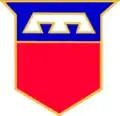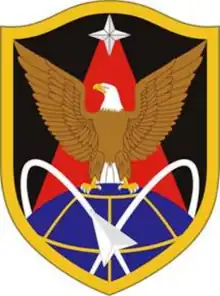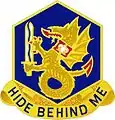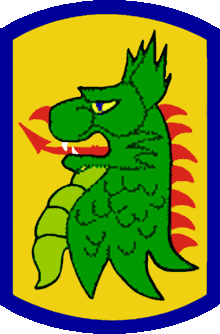76th Infantry Division (United States)
The 76th Infantry Division was a unit of the United States Army in World War I, World War II and the Cold War. The division was inactivated in 1996 and has been reconstituted as the 76th US Army Reserve Operational Response Command in 2013.[1]
| 76th Operational Response Command (formerly Infantry Division) | |
|---|---|
 76th Infantry Division shoulder sleeve insignia | |
| Active | 1917 – 1919 1921 – 1945 1963 – 1996 2013 – present |
| Country | |
| Branch | |
| Type | Infantry |
| Size | Division |
| Nickname(s) | "Onaway Division," "Liberty Bell Division" |
| Engagements | World War I |
| Commanders | |
| Current | MG Ernest Litynski |
| Insignia | |
| Distinctive unit insignia |  |
World War I
- Activated: August 1917 at Camp Devens, Massachusetts
- Overseas: August 1918
- Commanders: Maj. Gen. H. F. Hodges (5 August 1917), Brig. Gen. William Weigel (28 November 1917), Maj. Gen. H. F. Hodges (13 February 1918)
- Inactivated: May 1919
Order of battle
- Headquarters, 76th Division
- 151st Infantry Brigade
- 301st Infantry Regiment
- 302nd Infantry Regiment
- 302nd Machine Gun Battalion
- 152nd Infantry Brigade
- 303rd Infantry Regiment
- 304th Infantry Regiment
- 303rd Machine Gun Battalion
- 151st Field Artillery Brigade
- 301st Field Artillery Regiment (75 mm)
- 302nd Field Artillery Regiment (4.7 inch)
- 303rd Field Artillery Regiment (155 mm)
- 301st Trench Mortar Battery
- 301st Machine Gun Battalion
- 301st Engineer Regiment
- 301st Field Signal Battalion
- Headquarters Troop, 76th Division
- 301st Train Headquarters and Military Police
- 301st Ammunition Train
- 301st Supply Train
- 301st Engineer Train
- 301st Sanitary Train
- 301st, 302nd, 303rd, and 304th Ambulance Companies and Field Hospitals
Depot division
After arrival in France in July 1918, the division, less its 302nd Infantry Regiment and 151st Field Artillery Brigade, was designated as the 3rd Depot Division on 3 August 1918. Most of its troops were used as replacements for front line units which reduced the division to 7,000 troops. The division was skeletonized on 7 November 1918 - four days before the Armistice.
Interwar period
The division was reconstituted in the Organized Reserve on 24 June 1921 and assigned to the states of Connecticut and Rhode Island. The headquarters was organized on 1 September 1921.
World War II
- Ordered into active military service: 15 June 1942 at Fort George G. Meade, Maryland
- Overseas: 10 December 1944
- Campaigns: Ardennes-Alsace, Rhineland, Central Europe
- Days of combat: 107
- Distinguished Unit Citations: 2
- Awards: MH-2 ; DSC-11 ; DSM-1 ; SS-176; LM-5; SM19 ; BSM-1,312 ; AM-58
- Commanders: Maj. Gen. Emil F. Reinhardt (June–December 1942), Maj. Gen. William R. Schmidt (December 1942 – July 1945), Brig. Gen. Henry C. Evans (August 1945 to inactivation)
- Inactivated: 31 August 1945 in Europe
Order of battle
- Headquarters, 76th Infantry Division
- 304th Infantry Regiment
- 385th Infantry Regiment
- 417th Infantry Regiment
- Headquarters and Headquarters Battery, 76th Infantry Division Artillery
- 302nd Field Artillery Battalion (105 mm)
- 355th Field Artillery Battalion (105 mm)
- 364th Field Artillery Battalion (155 mm
- 901st Field Artillery Battalion (105&155 mm)
- 301st Engineer Combat Battalion
- 301st Medical Battalion
- 76th Cavalry Reconnaissance Troop (Mechanized)
- Headquarters, Special Troops, 76th Infantry Division
- Headquarters Company, 76th Infantry Division
- 776th Ordnance Light Maintenance Company
- 76th Quartermaster Company
- 76th Signal Company
- Military Police Platoon
- Band
- 76th Counterintelligence Corps Detachment
Intensive training began on 12 April 1943. This was followed by advanced training in July 1943 at A.P. Hill Military Reservation near Fredericksburg, Virginia. Winter training started in September 1943 at Camp McCoy in Wisconsin. (Skis, snowshoes, toboggans, snow tractors, snow goggles, winter camouflage suits, Eskimo parkas, etc.) Simultaneously, advanced training group moved in November 1943 to Northern Michigan near Watersmeet. Winter training experts from Mountaining Training Center at Camp Hale, Colorado gave special training program. Additional winter training began at Ottawa National Forest near Watersmeet, Michigan on 19 February 1944. During this training temperatures dropped to −28 °F (−33 °C).
Four exercises were conducted during which the 385th Infantry Regiment (headquartered in Pori, Michigan, opposed the division as an enemy force.
.jpg.webp)
On 12 March 1944, the division returned to Camp McCoy. 7,000 troops were taken from the 76th to build up forces for the impending invasion of France (D-Day) during April 1944.
In November 1944, trains headed to Camp Myles Standish in Taunton, Massachusetts for staging before transport to Europe. On Thanksgiving Day 1944, three transports sailed from Boston Port of Embarkation to Europe.
The 304th Infantry plus a Division Headquarters party sailed on the SS Brazil. The 304th reached Southampton, England on 4 December 1944.
The 385th Infantry crossed the Atlantic on the SS Sea Owl. The 385th reached Southampton on 4 December 1944.
The 417th Infantry sailed on the SS Marine Raven. The 417th docked at Plymouth 4 December 1944.
The remainder of the division sailed from Boston on 10 December 1944 aboard the Coast Guard operated transport SS Richardson. The SS Richardson docked at the Clyde River near Grenoch, Scotland on 12 December 1944.
The remainder of the Division Headquarters sailed from New York on 4 December on the Dutch liner New Amsterdam.

Combat chronicle
The 76th Infantry Division arrived in England, 20 December 1944, where it received additional training. It landed at Le Havre, France, 12 January 1945, and proceeded to the Limesy concentration area. The Division moved to Beine east of Reims and then to Champlon, Belgium, 23 January, to prepare for combat. Relieving the 87th Division in defensive positions along the Sauer and Moselle Rivers in the vicinity of Echternach, Luxembourg, 25 January, the 76th sent out patrols and crossed the Sauer, 7 February, and breached the Siegfried Line in a heavy assault. The advance continued across the Prum and Nims Rivers, 25–27 February. Katzenkopf fortress and Irrel fell on 28 February and the attack pushed on toward Trier, reaching the Moselle, 3 March. Driving across the Kyll River, the division took Hosten, 3 March, Speicher on 5 March and Karl on 10 March; swung south and cleared the area north of the Moselle, crossing the river, 18 March, near Mülheim an der Mosel. Moving to the Rhine, the 76th took over defenses from Boppard to St. Goar and crossed the Rhine at Boppard, 27 March. It drove east and took Kamberg in a house-to-house struggle, 29 March. A new attack was launched 4 April and the Werra River was reached the next day. The attack continued in conjunction with the 6th Armored Division; Langensalza fell and the Gera River was crossed, 11 April. Zeitz was captured after a violent struggle, 14–15 April, and the 76th reached the Mulde River on 16 April, going into defensive positions to hold a bridgehead across the Mulde near Chemnitz until VE-day.
Casualties
Awards
- Pvt. William D. McGee (Posthumously) 304th Infantry
- Pfc. Herman C. Wallace (Posth.) 301st Engineer Combat Battalion
- Capt. Robert Bertsch (Posth.)
- S/Sgt. Fred H. Brown (Posth.)
- 1st Lt. Clyde W. Ehrhardt
- Pvt. M. J. Fortuna (Posth.)
- 1st Lt. F. Gerard, Jr. (Posth.)
- 2nd Lt. Myron A. Mears
- T/5 Edgar Pelletier
- S/Sgt. Jacob M. Peter (Posth.)
- Sgt. Vito C. Pumilia
- Pfc. L. W. Satterfield (Posth.)
- Pfc. W. H. Shorey (Posth.)
- S/Sgt. Edward M. Transue (Posth.)
- S/Sgt. A. D. Webber (Posth.)
- Col. George E. Bruner
- Col. W. A. Choquette
- Col. Meade J. Dugas
- Brig. Gen. Henry C. Evans
- Col. Chifford J. Mathews
- Col. W. W. O'Conner
- Maj. Gen. William R. Schmidt
- Brig. Gen. Francis A. Woolfley
- CWO Raymond J. Dutra
Assignments in ETO
- 9 January 1945: 12th Army Group
- 14 January 1945: Fifteenth Army, 12th Army Group
- 19 January 1945: VIII Corps, Third Army, 12th Army Group
- 25 January 1945: XII Corps
- 3 April 1945: XX Corps
- 8 April 1945: VIII Corps
- 22 April 1945: VIII Corps, First Army, 12th Army Group
- 11 May 1945: VIII Corps, Ninth Army, 12th Army Group
Cold War to 1996
The 76th Division was reconstituted in October 1946 and reactivated in November of that year as a part of the Organized Reserve, and was headquartered in West Hartford, Connecticut. Units of the division were spread throughout the six New England states.
For the next 13 years, the division served as a traditional line Infantry division, training annually at Camp Edwards, Massachusetts and at Pine Camp (now Fort Drum), New York. In May 1959, the Division was re-designated and reorganized as the 76th Division (Training) with the mission of training initial (basic) entry soldiers of various branches and in later years the division also became able to train infantry volunteers or draftees.
In this role during 1985 and 1986, in an operation codenamed "Onaway Eagle", the division successfully defined, established and executed the first USAR (United States Army Reserve) mobilization army training center at Fort Campbell, Kentucky which became the model for utilization and employment of other reserve training divisions in the United States Army. In Operation Onaway Eagle, elements of the division successfully conducted Basic Combat Training for hundreds of new soldiers.
In 1990–1991, during Desert Shield and Desert Storm, the division validated and deployed to the Middle East over 600 of its soldiers where they served with distinction with the Third Army. As part of Operations Desert Shield and Desert Storm, the 1205th Transportation Railway Services Unit (later 1205th Transportation Railway Operating Battalion), based in Middletown, CT, was mobilized to augment civilian railway employees at Military Ocean Terminal Sunny Point, a U.S. Army munitions outport located just south of Wilmington, NC, bringing in tons of explosives by rail to the secure port for shipment to the war zone. On 1 October 1994, the division was again redesignated and on 18 April 1995 was reorganized as the 76th Division (Institutional Training). Just over two years later, the division was inactivated on 15 November 1996 at West Hartford, Connecticut. The commander at the time was BG John G Pappas, who served in this position from 1 Oct 1994 until 9 Sept 1996.
Reactivation in 2013 to present
In February 2013, Major General Daniel York sought a historical designation for a new command being stood up in the Army Reserve. The 76th Division was reactivated as the 76th USAR Operational Response Command (ORC) and is headquartered in Salt Lake City, Utah. Their mission is to provide operational engagement packages and joint enabling capabilities for homeland response, cyber defense, legal support, information operations, and global force space enhancement requirements to combatant, unified, Joint and Department of Defense Agency Commanders.[7]
From October 2015 to September 2017, Major General Ricky L. Waddell served as commanding general of the 76th Operational Response Command.
From November 2017 to June 2018, Major General A.C. Roper served as commanding general of the 76th Operational Response Command.
From June 2018 to July 2019, Brigadier General Douglas A. Cherry served as acting commanding general of the 76th Operational Response Command.
From July 2019 to March 2020, Major General Frederick R. Maiocco served as commanding general.
From March 2020 to August 2020, Brigadier General Douglas A. Cherry served as acting commanding general.
Major General Miles Davis is the current commanding general.
The command is made up of over 6,000 soldiers with a presence in all 50 states, the District of Columbia, Puerto Rico, the US Virgin Islands, and select locations in Europe.
Current composition
The current 76thORC is organised as follows:[8]
- 76th Operational Response Command, in Salt Lake City, Utah
- Emergency Preparedness Liaison Office
- HQ United States Army Reserve Elements and Augmentations
- FORSCOM Augmentation Unit
- Task Force 76
- 3rd Army Augmentation Company
 1st Space Brigade
1st Space Brigade
- 3rd Space Company
- 4th Space Company
- 5th Space Company
- 209th Regional Support Group
- 450th Chemical Battalion
- 453rd Chemical Battalion
- 468th Chemical Battalion
- 472nd Chemical Battalion
 415th Chemical Brigade, in Greenville, South Carolina
415th Chemical Brigade, in Greenville, South Carolina
 92nd Chemical Battalion
92nd Chemical Battalion- 457th Chemical Battalion
- 485th Chemical Battalion
- 490th Chemical Battalion
- United States Army Reserve Chemical Command
- 20th Support Chemical Detachment
 455th Chemical Brigade, in Sloan, Nevada (reactivated in 2019)[9][10]
455th Chemical Brigade, in Sloan, Nevada (reactivated in 2019)[9][10]
- 451st Chemical Battalion (Provisional), at Fort Dix, New Jersey
- 479th Chemical Battalion, at Fort Tilden, New York
- 462nd Transportation Battalion, in Trenton, New Jersey
- x2 Army Reserve Elements
General
- Nickname: Onaway Division; formerly called "Liberty Bell Division."
- Shoulder patch: An escutcheon with a red field and a blue chief, separated by an olive drab line; a three-pronged white device is superimposed on the blue chief.
- Battle Cry: "ONAWAY" – The "alert" signal of the Chippewa Indian warriors upon whose ground the 76th Division had trained.
References
- "76th United States Army Reserve Operational Response Command (formerly 76th Infantry Division) Heraldry". The Institute of Heraldry. Archived from the original on 16 September 2023. Retrieved 16 September 2023.
- Army Battle Casualties and Nonbattle Deaths, Final Report (Statistical and Accounting Branch, Office of the Adjutant General, 1 June 1953)
- Army Battle Casualties and Nonbattle Deaths, Final Report (Statistical and Accounting Branch, Office of the Adjutant General, 1 June 1953)
- Army Battle Casualties and Nonbattle Deaths, Final Report (Statistical and Accounting Branch, Office of the Adjutant General, 1 June 1953)
- Army Battle Casualties and Nonbattle Deaths, Final Report (Statistical and Accounting Branch, Office of the Adjutant General, 1 June 1953)
- Army Battle Casualties and Nonbattle Deaths, Final Report (Statistical and Accounting Branch, Office of the Adjutant General, 1 June 1953)
- "Premier Army Reserve Command gets new name". 6 February 2013. Retrieved 13 February 2014.
- "U.S. Army Reserve > Commands > Functional > 76th ORC". www.usar.army.mil. Retrieved 4 September 2020.
- "Army Reserve Chemical Brigade reactivated during historic ceremony". U.S. Army Reserve. Retrieved 4 September 2020.
- "455th Chemical Brigade". www.globalsecurity.org. Retrieved 4 September 2020.
- The Army Almanac: A Book of Facts Concerning the Army of the United States U.S. Government Printing Office, 1950 at http://www.history.army.mil/html/forcestruc/cbtchron/cbtchron.html Archived 21 March 2021 at the Wayback Machine
- We Ripened Fast – The Unofficial History of the Seventy-Sixth Infantry Division Edited by 1st Lt Joseph J. Hutnick, ADC and Tec4 Leonard Kobrick.